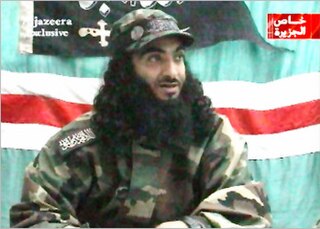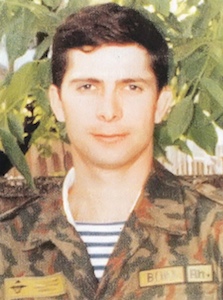
The First Chechen War, also referred to as the First Russo-Chechen War, was a struggle for independence waged by the Chechen Republic of Ichkeria against the Russian Federation from 11 December 1994 to 31 August 1996. This conflict was preceded by the battle of Grozny in November 1994, during which Russia covertly sought to overthrow the new Chechen government. Following the intense Battle of Grozny in 1994–1995, which concluded as a pyrrhic victory for the Russian federal forces, their subsequent efforts to establish control over the remaining lowlands and mountainous regions of Chechnya were met with fierce resistance from Chechen guerrillas who often conducted surprise raids.

The Second Chechen War took place in Chechnya and the border regions of the North Caucasus between the Russian Federation and the breakaway Chechen Republic of Ichkeria, from August 1999 to April 2009.

The Russian Airborne Forces is the airborne forces branch of the Russian Armed Forces. It was formed in 1992 from units of the Soviet Airborne Forces that came under Russian control following the dissolution of the Soviet Union.

Spetsgruppa "A", also known as Alpha Group, or Alfa, whose official name is Directorate "A" of the FSB Special Purpose Center, is a stand-alone sub-unit of Russia's special forces within the Russian Federal Security Service (FSB). It was created by the Soviet KGB in 1974. Although little is known about the exact nature of its primary directives, it is speculated that the unit is authorised to act under the direct control and sanction of Russia's top political leadership, similar to its sister unit, the Directorate "V" (Vympel), which is officially tasked with protecting Russia's strategic installations, as well as conducting black operations inside and outside Russia. It is also available for extended police duties, for paramilitary operations, and for covert operations, both domestically and internationally.

Gennady Nikolayevich Troshev was a Russian colonel general and a former commander of the North Caucasus Military District, including Chechnya, during the Second Chechen War. He was awarded a Hero of Russia award.

Vladimir Anatolievich Shamanov is a retired Colonel General of the Russian Armed Forces who was Commander-in-Chief of the Russian Airborne Troops (VDV) from May 2009 to October 2016 and a Russian politician. After his retirement in October 2016, Shamanov became head of the State Duma Defense Committee.

On 19 August 2002, a group of Chechen fighters armed with a man-portable air-defense system brought down a Russian Mil Mi-26 helicopter in a minefield, which resulted in the death of 127 Russian soldiers in the greatest loss of life in the history of helicopter aviation. It is also the most deadly aviation disaster ever suffered by the Russian Armed Forces, as well as its worst loss of life in a single day since the 1999 start of the Second Chechen War.

The First Battle of Grozny was the Russian Army's invasion and subsequent conquest of the Chechen capital, Grozny, during the early months of the First Chechen War. The attack would last from December 1994 to March 1995, which resulted in the military occupation of the city by the Russian Army and rallied most of the Chechen nation around the government of Dzhokhar Dudayev.

Igor Dmitriyevich Sergeyev was a Soviet and later Russian military officer who was Minister of Defense of Russia from 22 May 1997 to 28 March 2001. He was the first and, as of 2024, the only Marshal of the Russian Federation.

The 1999–2000 battle of Grozny was the siege and assault of the Chechen capital Grozny by Russian forces, lasting from late 1999 to early 2000. This siege and assault of the Chechen capital resulted in the widespread devastation of Grozny. In 2003, the United Nations designated Grozny as the most destroyed city on Earth due to the extensive damage it suffered. The battle had a devastating impact on the civilian population. It is estimated that between 5,000 and 8,000 civilians were killed during the siege, making it the bloodiest episode of the Second Chechen War.

The 106th Guards Tula Red Banner Order of Kutuzov Airborne Division, more generally referred to as the Tula Division, is one of the four airborne divisions of the Russian Airborne Troops, the VDV. Based in the city of Tula, to the south of Moscow, it is administratively located within the Western Military District. в/ч 55599

The 2000 Zhani-Vedeno ambush took place on March 29, 2000, when a mechanized column of Russian Interior Ministry troops was ambushed in the southern Vedensky District of Chechnya. As the result of the attack on the convoy and on Russian relief forces, scores of Russian special police and paramilitary troops were killed or captured. 37 OMON officers in the column and six in a relief column were killed and 11 more were taken hostage, 9 of whom were executed soon after Russian command refused to swap them for the arrested military officer Yuri Budanov.

Abu al-Walid was a Saudi Arabian of the Ghamd tribe who fought as a "mujahid" volunteer in Central Asia, the Balkans, and the North Caucasus. He was killed in April 2004 in Chechnya by the Russian federal forces.
The Battle of Komsomolskoye took place in March 2000 between Russian federal forces and Chechen separatists in the Chechen village of Komsomolskoye (Saadi-Kotar), Chechnya. It was the largest Russian victory during the Second Chechen War. Several hundred Chechen rebel fighters and more than 50 Russian servicemen were killed in the course of more than two weeks of siege warfare. An unknown number of civilians were killed in the fighting as well. The fighting resulted in the destruction of most of the forces of Chechen rebel field commander Ruslan Gelayev. Scores of Chechens were taken prisoner by the Russians, and only a few survived. A number of civilians died from torture, and the village was looted and destroyed. The battle was the bloodiest of the entire Second Chechen War, and was marked by fierce urban combat.

Mark Nikolayevich Yevtyukhin was a Russian Lieutenant-Colonel and Commander of the Pskov-based 2nd Battalion, 104th Guards Airborne Regiment, 76th Guards Airborne Division, who was killed in action during the Battle for Height 776.0 near Ulus-Kert, Chechnya. For his actions in that battle, he was posthumously honoured as a Hero of the Russian Federation.

The 31st Separate Guards Order of Kutuzov 2nd class Air Assault Brigade is an airborne infantry brigade of the Russian Airborne Troops, based in Ulyanovsk. The brigade was formed in 1998 from the 104th Guards Airborne Division. The brigade fought in the Second Chechen War and the Russo-Georgian War. During the Crimean crisis 2014 elements of the brigade entered Ukraine's Crimean peninsula. In August 2014 brigade's units participated in the war in Donbas. The brigade fought in the 2022 Russian invasion of Ukraine, beginning with the Battle of Antonov Airport.

The 108th Guards Kuban Cossack Air Assault Regiment is a regiment of the Russian Airborne Troops' 7th Guards Airborne Division, based at Novorossiysk. The regiment fought in the suppression of the Hungarian Revolution of 1956, the Warsaw Pact invasion of Czechoslovakia, the War in Abkhazia, the First Chechen War, the War of Dagestan and the Second Chechen War, and the Invasion of Ukraine of 2022.

The 331st Guards Airborne Regiment is a formation of the Russian Airborne Troops. The regiment, a part of the 98th Guards Airborne Division, was considered to be one of Russia's elite units, but suffered large losses during the Russian invasion of Ukraine that started in February 2022.
The Chechen Republic, commonly known as Chechnya, is a federal republic of Russia that has been noted in several roles during the Russian invasion of Ukraine. Kadyrovite forces have fought alongside the Russian forces, while several Chechen armed volunteer formations are fighting on the Ukrainian side. International observers have noted a number of comparisons between the invasion and the First and Second Chechen Wars.


















